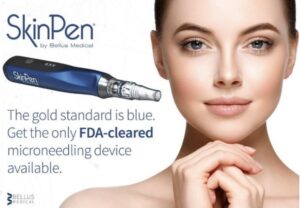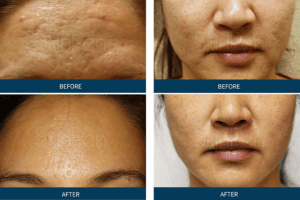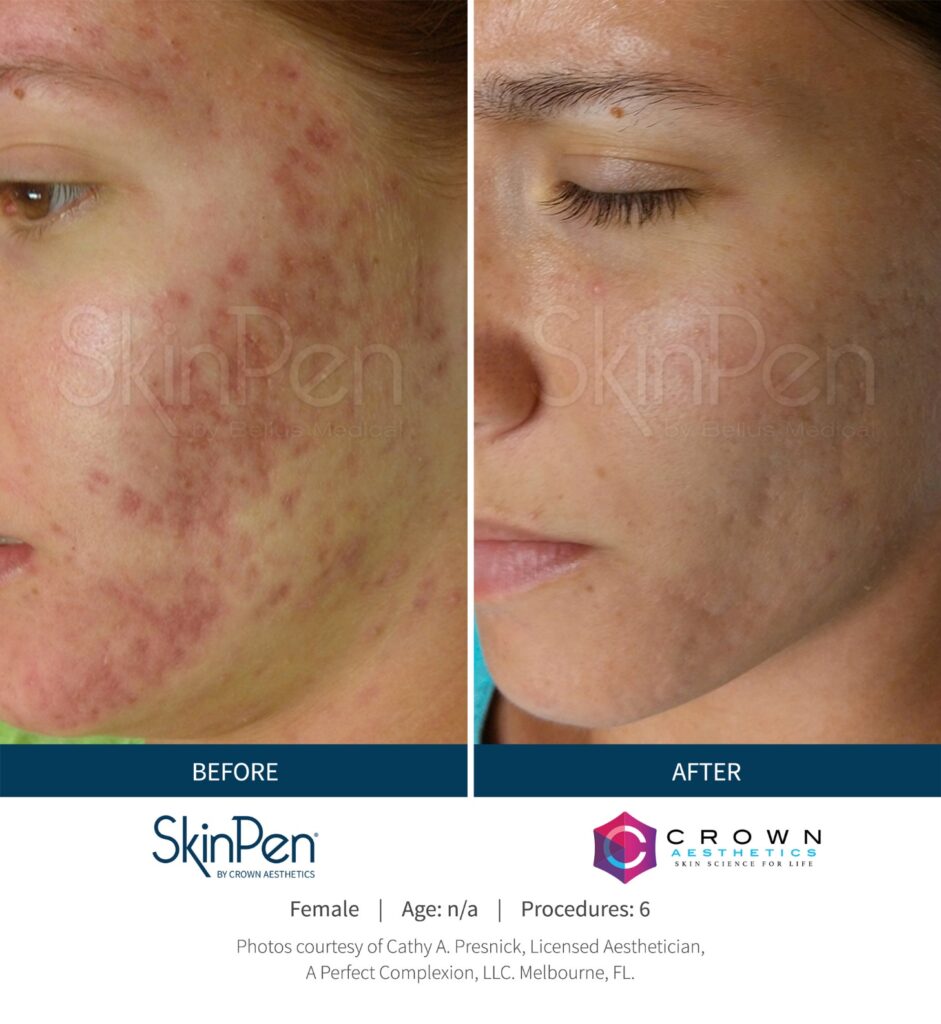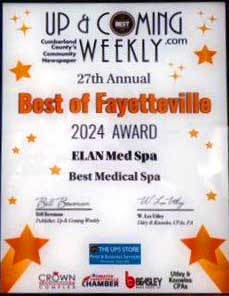Collagen Induction Therapy
SkinPen®

SkinPen®, also known as collagen induction therapy or micro-needling, stimulates your skin’s natural ability to repair itself and produce new collagen and elastin for healthier, younger-looking skin. SkinPen is extremely versatile and can be used on all parts of the body: face, neck, décolleté, arms, legs, abdomen, and back.
How does it work?
SkinPen® creates microscopic channels that allow for controlled induction of the skin’s self-repair mechanism. This in turn triggers new collagen and elastin fibers to form creating a result of smoother, firmer, and younger-looking skin. SkinPen can reverse years of sun damage, improve acne & surgical scars, reduce pore size, and enhance the overall appearance of aging skin.
Am I a candidate?
Yes! SkinPen® is FDA-approved to be performed on all Fitzpatrick skin types.

Who is NOT a candidate?
SkinPen® treatments are contraindicated for patients with: keloid scars, scleroderma, collagen vascular diseases or cardiac abnormalities, a hemorrhagic disorder or hemostatic dysfunction, and active bacterial or fungal infection. If you have taken oral isotretinoin (Accutane), you must wait at least six months before a SkinPen treatment.
SkinPen treatments have not been evaluated in the following patients, as such, precautions should be taken when determining whether to treat: scars and stretch marks less than one-year-old; women who are pregnant or nursing; keloid scars; patients with a history of eczema, psoriasis and other chronic conditions; patients with a history of actinic (solar) keratosis; patients with history of herpes simplex infections; diabetics or patients with wound-healing deficiencies; patients on immunosuppressive therapy; and skin with presence of raised moles or warts or targeted area.
What is the downtime?
After the procedure, the skin will be red and flushed in appearance in a similar way to moderate sunburn. You may also experience skin tightness and mild sensitivity to touch on the area being treated. Total healing time depends on the severity of the damaged skin and the depth of the repair process required. On average, patients are pink for two to four days. Some patients heal completely in 24 hours.
When will I see the results?
Most people notice healthier-looking skin immediately. The natural repair process of the skin continues to progress over the course of several weeks. Dermal collagen remodeling takes place over time and it will continue to improve for up to 6 months after treatment.


How many treatments will I need?
The number of treatments required will vary from patient to patient and your provider will personalize a treatment plan based on the level of improvement you desire. Although one treatment is beneficial, a series of treatments is usually recommended. Multiple treatments (3-6) may be necessary over 4-8 week intervals. After your initial treatment series, periodic maintenance may be advised (depending upon the condition(s) treated). Your provider may also combine your treatment with other popular aesthetic procedures to further personalize your treatment.
What should I do to prepare for this treatment?
Within 2 weeks prior to your treatment discontinue the following: topical retinoid, waxing, depilatory use, electrolysis, laser hair removal.
What should I expect after my treatment?
You are likely to experience some mild to moderate redness, stinging, skin flaking, and/or mild irritation. Most patients leave looking like they have a sunburn. This will dissipate throughout the day. Most patients will have some light to mild flaking over the next couple of days.
Fractional Radiofrequency Microneedling
Microneedling also known as collagen induction therapy, is the process of finely puncturing the skin with very fine gold-plated needles. This helps to promote collagen production as the skin begins to heal the wounds, reducing the appearance of wrinkles and age spots and smoothing skin.
When used in combination with PRP, this treatment can help further promote the production of collagen in patients’ areas of concern. This will enhance and maintain overall results, as both treatments will help skin heal in various ways.
Fractional Radiofrequency microneedling is a skin-resurfacing technique that uses microneedles that emit radiofrequency waves to promote collagen production in the deepest layers of the skin. It can be used to reshape certain areas of the face and improve contours, which can, in turn, tighten and rejuvenate skin.
This treatment is frequently used to tighten skin and improve overall skin texture and tone, which works well in combination with PRP’s rejuvenating effects of enhanced collagen production. By combining these two treatments, providers can improve multiple areas of the patient’s skin on a reduced schedule, meet their skin goals sooner, and get better overall results.
Exosomes
Regenerative Aesthetics is an innovative branch of aesthetic medicine that focuses on harnessing the body’s natural healing abilities to address aging and cosmetic concerns.
This approach emphasizes the use of nonsurgical treatments to tighten, tone, and revitalize the skin, promoting long-term skin health and restoring a youthful appearance. By utilizing natural ingredients and cutting-edge technologies, regenerative aesthetics supports the body’s biological healing processes, offering a more holistic and sustainable solution to cosmetic concerns.
As an offshoot of regenerative medicine, regenerative aesthetics aims to enhance the body’s innate system or natural repair and healing, particularly in the context of facial aging.
Some of the key issues that regenerative aesthetics can effectively tackle include wrinkles, lax or sagging skin, stretch marks, neck, enlarged facial pores, crepey skin, stretch marks, acne scars, and surface discoloration. Additionally, these treatments may be recommended for conditions such as acne breakouts and rosacea.
Platelet-Rich Plasma (PRP) and Platelet-Rich Fibrin (PRF):
These treatments utilize the patient’s own blood components to stimulate tissue regeneration and collagen production.
Exosome Treatments:
These cell-derived vesicles play a crucial role in cell signaling and tissue regeneration, making them a valuable tool in regenerative aesthetics.
Exosomes, tiny vesicles secreted by cells, have emerged as a cutting-edge treatment in regenerative aesthetics. These membrane-bound structures contain growth factors, proteins, and genetic material that can influence cellular behavior and promote tissue regeneration.
Exosome therapy has shown potential in various aesthetic applications, including skin rejuvenation, scar revision, and hair restoration. Studies have demonstrated that exosomes can enhance outcomes in these areas by modulating cellular processes and promoting healing.
Growth factors, often derived from platelet-rich plasma or exosomes, play a crucial role in regenerative aesthetics. These proteins stimulate cell growth, proliferation, and differentiation, contributing to tissue repair and rejuvenation.
Sculptra®
Sculptra(injectable poly-L-Lactic acid)is indicated for use in people with healthy immune systems for the correction of shallow to deep nasolabial fold contour deficiencies, fine lines, wrinkles in the cheek region, and other facial wrinkles.
Sculptra is an injectable implant containing microparticles of poly—L-Lactic acid, (PLLA).
- PLLA helps replace the lost collagen in the skin.
- PLLA helps stimulate the gradual restoration of the collagen framework.
- PLLA is eventually broken down by the body in the dermis.
Replacement and restoration of the collagen framework help to create a subtle, refined correction of wrinkles.
A proven safety profile over years of clinical use has placed Sculptra as one of the most sought-after collagen induction therapies.
Sculptra lasts up to 2 years and it is absorbed in 24 to 48 hours.
On-label treatment areas for Sculptra are:
- Cheeks
- Nasolabial folds
- Piriform fossa
- Marionette lines
- Pre-auricular wrinkles
- Submalar wrinkles
- Chin wrinkles

